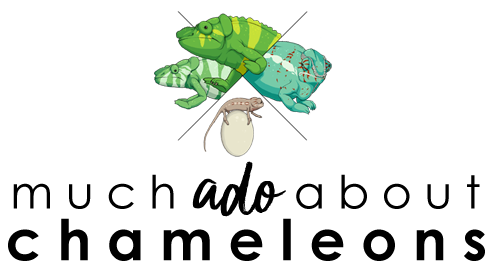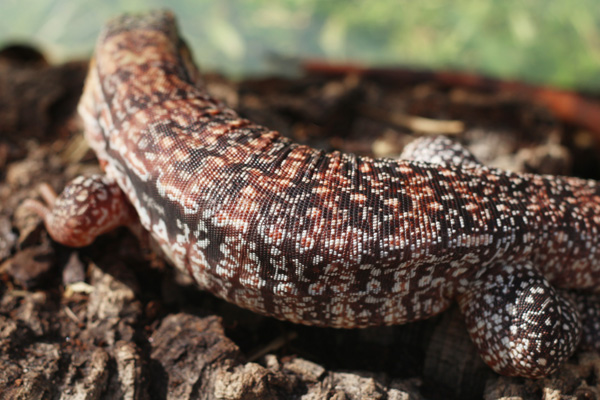For diurnal (day-time) reptiles, not providing the proper lighting is like not providing fish with water. They aren't thrashing around but they are doomed to perish none the less. So the importance of making sure your reptile has proper lighting cannot be understated. It extends far beyond the need for heat, which is also vital, but also to the need to replicate the full spectrum of light that the sun is outputting. In this blog, I will be talking about the all-important light: the ultraviolet spectrum, particularly UVB.
Basking bulbs not only provide reptiles with a heat spot in which to bask and warm up, but they provide the visible spectrum of light that mimics daylight. Just as the mood of people declines when they do not experience daylight, so do reptiles. So it's important to use white light bulbs, and not blue or red when keeping a diurnal reptile.
 However, the UVB is the spectrum of light that we humans cannot see but that is supremely important to the long-term health of reptiles. Like us, reptiles make the vital vitamin D3 in their skin when exposed to the UVB from the sun, and this vitamin in turn allows calcium to be absorbed by the bones. Therefore, when this light spectrum is not provided they cannot absorb calcium as efficiently and a young reptile will begin to show calcium deficiencies in the form of bone deformities (bowing of the long bones in the arms and legs, bone fractures, curving in the spine and tail, etc.) and loss of muscle control. To learn more about the effects of different vitamins and minerals in the body of chameleons, refer to this blog: Chameleon Physiology & Supplements
However, the UVB is the spectrum of light that we humans cannot see but that is supremely important to the long-term health of reptiles. Like us, reptiles make the vital vitamin D3 in their skin when exposed to the UVB from the sun, and this vitamin in turn allows calcium to be absorbed by the bones. Therefore, when this light spectrum is not provided they cannot absorb calcium as efficiently and a young reptile will begin to show calcium deficiencies in the form of bone deformities (bowing of the long bones in the arms and legs, bone fractures, curving in the spine and tail, etc.) and loss of muscle control. To learn more about the effects of different vitamins and minerals in the body of chameleons, refer to this blog: Chameleon Physiology & Supplements |
| A chameleon showing severe calcium deficiency deformities and fractures. Photo from this forum thread: What MBD Looks Like, Chameleonforums.com |
Even though we use powered vitamin D3 as a supplement, studies in scientific journals show that providing D3 only via diet is not an effective long-term solution and that the reptile will develop deficiencies anyway (and worse, artificial D3 overdoses, which can lead to the calcification of the tissues). The only way to ensure that your reptile is getting the adequate levels of natural D3 is to provide a good UVB light from a reptile brand. People are often reluctant to purchase them because they can be a little expensive but they are vital, and can be found cheaper from online sources if one knows where to look. Providing one is the best way to make sure your reptile's bones and system absorb calcium properly.
CHOOSING A UVB BULB
This can be confusing, but it doesn't have to be. The most commonly recommended brand is Zoo Med Reptisun 5.0 or 10.0, which is easily available. A cheaper bulb is the Exo Terra Reptiglo 5.0, but I would not buy these (at least go for the 10.0 bulb) because its UV output is really minimal, in my opinion.
Then there are very powerful (and slightly more expensive bulbs) from brands such as ReptileUV or Arcadia, but these are excellent bulbs and have much more powerful UV outputs. The Megaray bulbs by ReptileUV are better for free ranges or huge cages, as they are both heat and UVB bulbs and are very powerful. These would roast a chameleon in a small cage who cannot escape the light. The Arcadia 6% or 12% bulbs are only UVB lights and provide much stronger levels than the common brands and therefore last much longer between replacements.
With any UVB bulb it is important to provide areas of shade so the chameleon can choose whether to be in the light or not.
NATURAL SUNSHINE
In addition, if your weather allows, I believe that getting your reptiles outside for some natural sunshine is one of the best things you can do for them. There isn't an artificial bulb available that recreates the sun in everything that it provides, so outside is when you usually see your reptiles (chameleons particularly) at their very best, color-wise. While these commercial bulbs provide the adequate UVB output for reptiles to do well throughout their lives, nothing compares to the sun itself.
Below is a graph showing the UVB readings throughout the day at different locations across the planet. The graph comes from UV Guide UK, which is an excellent source to not just buy a UV meter but to learn about the different UV readings, either outside or by different bulb brands.
 |
| SOURCE: http://www.uvguide.co.uk/uvinnature.htm. But graph shows UVB readings throughout the day at different locations across the planet. |
*IMPORTANT: Make sure you provide your chameleon with shaded areas and access to water in case it is very hot out. While you want them to get some sun, you don't want them to overheat in the process. And never ever have them outside in a glass tank!
KEEPING REPTILES OUTSIDE?
If you are reading this and wondering, "could I keep my reptile outside instead of indoors?" the answer is yes! If your climate meets your animal's temperature and humidity needs and if the enclosure provides shade, water, hiding places, and protection from wildlife like raccoons or hawks. I will keep my chameleons in outdoor cages for days or weeks at a time and they do really well, but my climate here in Florida will be very different from that of Montana or Germany, so your climate needs to be considered very carefully.












Great article. I live in southern california and would like to keep my veiled outside on my porch but it gets very little direct sunlight. How much direct sunlight is needed? Is this something that id need a meter to determine? Thanks for the info!
ReplyDeleteThanks! A UV meter is definitely a handy tool to have, although they can be pricey. But I think that as long as they can get a few hours of sunshine (especially in the morning, to warm up) they can do fine in shade the rest of the day. One study on reptiles and UV said that just 20 minutes in direct sunlight created blood vitamin D3 levels that could still be detected 2 weeks later. So this suggests that they don't need to bask for UV all day, a short while is enough to make the vitamin, even though there are still usually good levels of UV even in shade (typically higher even than what artificial lights output!)
DeleteMine are outside right now and they get direct sunshine in the morning (about 8-11) and shade the rest of the day. That basking time is enough to get them warm and active all day long.
A really great website where you can see the UV readings outside, even in shade: http://www.uvguide.co.uk/uvinnature.htm
Hope that helps!
Thanks! Looks like I have some more research to do before I select the right spot for him. Whats your supplementation schedule like for your outdoor chams? Any D3 at all?
DeleteRight now since they are outside full time, they get almost no D3. So they get Repashy plain calcium every meal (depending on their age they eat every 2 days to daily) and then Repashy calcium plus (which has calcium, multivitamins, and D3) about once a month. I essentially just use it for the multivitamin. Indoors I would have used the calcium plus 2-3 times weekly, very lightly.
DeleteThanks again! Great blog!
DeleteOlimpia, I know this is a year later but do you still have yours full time outside in July?
DeleteYes I do, right now during summer even though it's hot we have rainstorms almost on a daily basis so it's perfect for them. I mist very frequently during the day when it's very hot and the cages are in the shade nearly the entire day. But then in the afternoon it usually rains and the day cools off, so my chameleons do really well outside.
ReplyDeleteHelp! I believe our female veiled chameleon has MBD. My daughter brought it home from her grandpas. The pet store said they didn't need a heat lamp or a UVB. She is a few months old. This week I haven't seen her eat. We tried tonight to hold a cricket for her to eat but she wouldn't. What can I do?
ReplyDeleteHey Shelly, sorry that the pet store gave you such bad info. They do need a heat bulb (for a little female a 45-60w household incandescent should do, they don't need it much warmer than 80-85F) and a UVB bulb. Something like a Reptiglo 10.0 or a Reptisun 10.0 would be the two easiest to find at a local pet store.
DeleteYou would want to set the lights up over the cage and have them on 12 hours on (or I follow the sun, so right now in winter it's more like 10 hours on) and 12 hours off. She will need complete darkness to sleep, so don't worry about getting her a red bulb or anything like that that pet stores like to trick you into needing.
She may have MBD from the lack of UVB lighting but it's also possible that she's not eating because she's too cold. Without any heat they can't run their bodies like we do, so she will just sit in one spot and not move because she literally can't. Providing her with the basking spot and UVB light should help her become more active and get her appetite back.
If she does have MBD look into purchasing a calcium powder without any vitamins at all (usually Amazon is a cheap source, should be no more than $5), so just plain calcium with NO vitamin D3 or anything. This, dusted on her food, will help rebuild her bones.
Hello. Hoping you can help. We live in Orlando and just got our first chameleon. He's in great health and we have the reptibreeze open air screen cage setup for him out on our screen enclosed deck. The area of the deck we put him in is covered so doesn't get direct open sunlight. Will this provide him UVA/B that he needs or should we move his cage for the 20 minutes a day to direct sunlight. We're getting a place for him to get shade in today as I'm afraid with the temp around 90 degrees right now that it may get too hot for him. He got a bit skiddish after we got him home, but I hope he'll become less stressed over the next couple of days so he will come out of his cage.
ReplyDeleteCongrats on the new chameleon! I assume it’s a veiled chameleon? They do really well outside here in Florida, I work down in Homestead by the Everglades and we see them now and then running around wild.
DeleteThe tentative answer is that he is *probably* getting all the UVB he needs even in the shade, however, since there are two layers of screen in between that cuts down on how much UVB actually makes it into the cage. If there is a corner that gets even a little bit of direct sunshine throughout the day (maybe early morning or afternoon) that would make me feel a little more comfortable. I’ve kept chams outside on porches and lanais but they always got at least a bit of direct sunshine throughout the day, even if it was only an hour early in the morning.
He’ll definitely relax with time, let him get used to everything for about a week or two and then you can start gently seeing if he’ll come out, eat from your hand, etc.
hello Olimpia ..
ReplyDeleteI live in Indonesia , i think the weather here just the same with florida which is tropical country.
I keep my panther chameleon in outdoor cage with all screen mesh.
the day temp here around 93-95 with 50-55% humidity.
I have 1 months baby panther chameleon which i keep in outdoor cage too.
1 thing i want to ask is the ideal misting schedule for them ..
i already set up misting system that run from 8AM - 5PM , each hours for 2 minutes, except at 12PM it run for 3 minutes , then 3 PM it run for 5 minutes.
what im thinking is i want to create time for them to cleaning them self, so i set the schedule long enough for them.
Any suggestion for me ?
You see the U.S. Constitution concedes TECHNOLOGY UNIVERSITY no specialist over education to the central government.
ReplyDeleteIt was a noteworthy test for teachers amid the most recent decade. The implications of economical advancement in educational set ups, the proper equalization of harmony, human rights, citizenship, social value, environmental and improvement subjects in effectively over-burden educational module, electrical installation
ReplyDelete
ReplyDelete8. The next time I read a blog, I hope that it doesnt disappoint me as much as this one. I mean, I know it was my choice to read, but I actually thought youd have something interesting to say. All I hear is a bunch of whining about something that you could fix if you werent too busy looking for attention. st brittos academy
Congratulations to all of the participants of this program. mayo international I bet they learned a lot from the project. This will help me for a school project. Keep the posts coming.
ReplyDeleteGood I like it. fiver online logo design services in usa
ReplyDeleteCurrent monetary difficulties and increasing expenses of education are the inspiration driving improved money related help to students. see more
ReplyDeleteเล่นเกม สล็อต slot online slot online เครดิตฟรี
ReplyDeletehttps://www.live22easy.com/
You may want to alternate colors to make your chain look even more extravagant but pretty much let your children make the ultimate decision so they will feel as if they created the chain. Glitter in bulk
ReplyDeleteIt was contemplating whether I could use this audit on my other site, I will associate it back to your site though.Great Thanks. online diploma in pakistan
ReplyDelete